 |
||
|
||
| ||
The second edition, updated.If you are tired of cards which look like twins we can suggest you try a bit of exotics... What's the difference between the cards of brandname manufacturers and just ordinary ones, beside the price? Quality. And not only production quality but first of all the quality of components. Yet half a year ago the problems with cards from such manufacturers as AXLE, SuperGrace, Butterfly, Daytone, Innovision were were quite ordinary - for little money a user could get cards not the best in quality and in performance. NVIDIA has solved a problem with card quality on the base of their GPU rather simple - all NVIDIA partners which were producing cards on their chipsets got a card's reference-design and complete sets of graphics processors together with video memory. As a result nearly all NVIDIA GPU based cards were like twins differing only in price and a little in performance. Now you can buy practically any card based on NVIDIA GPU and you won't disappointed in speed and image quality. Nevertheless, all of us are a bit individualists eager for something special. But for rational sum and with decent performance. So, meet the exotics. Today we are going to deal with the cards of SUMA from South Korea. SUMA stands for SuperMicro System (it's not the american SuperMicro). SUMA was founded in 1998 and immediately became an exclusive partner of AOpen. A bit later SUMA concluded contracts with 3dfx (at that time they produced only Voodoo2 and Voodoo Banshee chipsets) and with NVIDIA (Riva TNT). As a result, SUMA became very popular both in Korea and in other countries of the South-East Asia. SUMA achieved some popularity even in the USA. Unfortunately, in Europe this company is hardly known. SUMA is dealing not only with video card production, but also with MP3-players, WEB-cameras etc. Besides, SUMA is also known to implement special production orders, e.g. a well-known mainboard AX6BX Pro II Millennium Edition for AOpen. We succeeded to receive eight cards of the Platinum series from SUMA. Three of them are based on GeForce2 GTS GPU, one is on the GeForce2 Pro, and the other four are powered by the GeForce2 MX GPU (after all, we considered different versions of some cards). The second edition has received the following video cards:
First of all comes the testbed:
1. SUMA Platinum GeForce2 GTS SE (Special Edition) 64 MBytes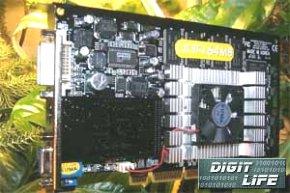 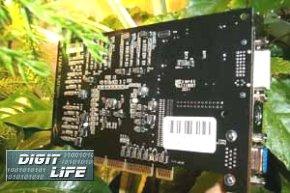 The video card has the AGP Pro interface (compatible with the AGP 2x/4x), 64 MBytes DDR SDRAM from Hyundai located in 8 chips on the right side of the PCB. 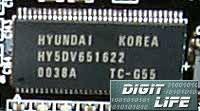 Note that the memory modules have 5.5 ns access time and not 6 ns as it was written in the specification for the cards based on the GeForce2 GTS from NVIDIA. And as a result, the default memory frequency constitutes not 166 MHz but 183 MHz (366 MHz). The features of the SUMA Platinum GeForce2 GTS SE (Special Edition) 64 MBytes:
The card is supplied with an unusual active cooler, quite big in size what should help proper cooling of the GPU and provide high opportunity for overclocking. Though, in case of the Leadtek WinFast GeForce2 GTS, which has a rather big cooler as well, we made sure that however cold is the GPU you won't help it if it doesn't work at irregular frequencies. On the black in color PCB you can distinguish bright silvery letters making the name. You can see that the card is equipped with the whole set of additional functions such as TV-out (on the daughter board), DVI interface. In general the card follows the reference design, what ensures the high reliable work and full conformity to the NVIDIA parameters for the GeForce2 GTS based cards, except only the AGP Pro connector. Besides, I should notice that the AGP Pro based video cards excellently work in AGP 2x/4x slots. The card is shipping in the box of quite original design: 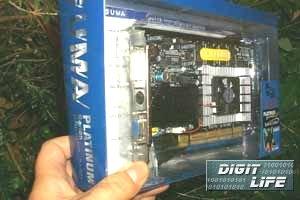 I have never seen such transparent plastic enclosures for video cards. The complete set contains:
OverclockingWith this card we managed to overclock the chip up to 225 MHz (unfortunately the large heatsink didn't assist in lifting the frequency even more), the memory was working up to 410 MHz. Considering that in the cards of this class memory overclocking makes the greatest contribution in performance gain, you should expect a considerable speed increase when working at irregular frequencies. Installation and driversSUMA ships together with the card the reference drivers from NVIDIA of 5.33 version. For testing I used 6.47 beta drivers from NVIDIA. 2. SUMA Platinum GeForce2 GTS 32 MBytes  The video card has the AGP 2x/4x interface, 32 MBytes DDR SGRAM located in 4 chips on the right side of the PCB. Note that on the other side there are blank spaces for the same memory modules (that is it makes possible production of 64 MBytes cards on the base of this PCB). 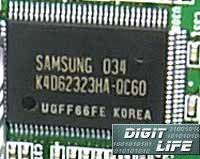 The modules have 6 ns access time and are produced by Samsung, what is quite amazing since we used to see Infineon memory on 32 MBytes cards of this class. The default memory frequency constitutes 166 MHz (333 MHz). This card is supplied with a silvery active cooler quite big in size, exactly the same as of the SUMA Platinum GeForce2 GTS SE. Unfortunately , the card above shows that proper cooling doesn't ensure good overclockability of the graphics core. The PCB is green with bright silvery letters of the name. This card is equipped more modest - neither TV-out nor DVI interface. In the whole, the card follows the reference design from NVIDIA, what ensure reliable operating. The card is shipping in the box of quite original design: 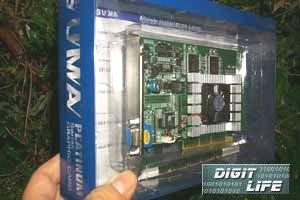 The complete set is very similar to that of the SUMA Platinum GeForce2 GTS SE (Special Edition) 64 MBytes, but for the absence of a DVD-Video disc. OverclockingWith this card we managed to overclock the chip up to 225 MHz, the memory was working up to 410 MHz what is quite unusual for 6 ns chips. Installation and driversSUMA ships together with the card the reference drivers from NVIDIA of 5.33 version. For testing I used 6.47 beta drivers from NVIDIA. 3. SUMA Platinum GeForce2 GTS 64 MBytes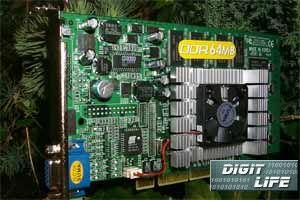  The video card has the AGP Pro interface (compatible with the AGP 2x/4x), 64 MBytes DDR SDRAM from Hyundai located in 8 chips on the right side of the PCB. 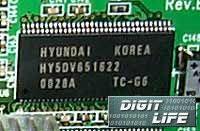 The modules has 6 ns access time. The default memory frequency constitutes 166 MHz (333 MHz). This card is supplied with a silvery active cooler quite big in size, exactly the same as of the SUMA Platinum GeForce2 GTS SE. The PCB is green. This card has neither TV-out nor DVI interface. In the whole, the card follows the reference design from NVIDIA, what ensure reliable operating. The card is shipping in the box of quite original design: 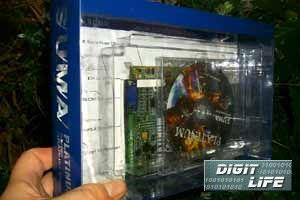 The complete set looks the same as that of the SUMA Platinum GeForce2 GTS SE (Special Edition) 64 MBytes. OverclockingWith this card we managed to overclock the chip up to 230 MHz, the memory was working up to 410 MHz what is quite unusual for 6 ns chips. Installation and driversSUMA ships together with the card the reference drivers from NVIDIA of 6.18 version. For testing I used 6.47 beta drivers from NVIDIA. 4. SUMA Platinum GeForce2 Pro 64 MBytesThis card is represented by an engineering sample from SUMA only one in quantity. The production of this cards hasn't been started, the company is now considering the expediency of release of this model. 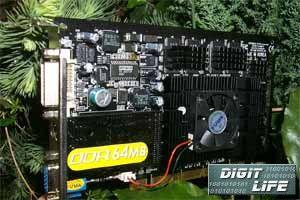 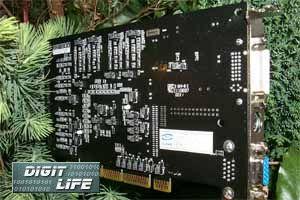 The video card has the AGP Pro interface (compatible with the AGP 2x/4x), 64 MBytes DDR SDRAM from EliteMT located in 8 chips on the right side of the PCB. The chips are covered with the glued heatsinks. 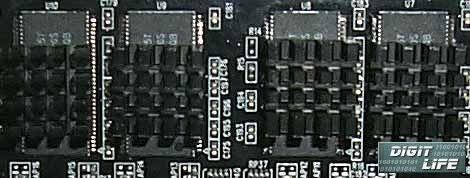 Note that the memory modules have 5 ns access time. The default memory frequency constitutes 200 MHz (400 MHz). The features of the SUMA Platinum GeForce2 Pro:
 The card has a black active cooler of the same construction. Taking it off you can see the chipset itself. The black PCB has bright silvery letters of the name. The card is equipped with the whole set of additional functions such as a TV-out (on the daughter board), a DVI interface. In general, the card follows the reference design, what ensures the high reliable work and full conformity to the NVIDIA parameters for the GeForce2 Pro based cards. Besides, I should notice that the AGP Pro based video cards excellently work in AGP 2x/4x slots. The card is shipping in the box of quite original design:  The complete set includes:
OverclockingUnfortunately, this sample didn't justify hopes, the memory worked only at 420 MHz, the chipset only at 220 MHz. That's why it makes useless to consider the overclocking. Installation and driversSUMA ships together with the card the reference drivers from NVIDIA of 6.18 version. For testing I used 6.47 beta drivers from NVIDIA. 5. SUMA Platinum GeForce2 MX 32 MBytes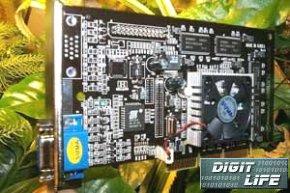 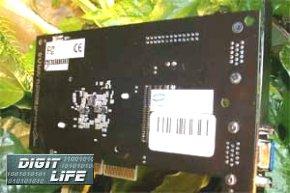 This is the first card from SUMA out of the whole series that is built on the GPU GeForce2 MX. The card has the AGP 2x/4x interface, 32 MBytes SDR SDRAM located in 4 chips on the right side of the PCB. 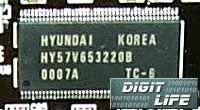 The memory modules have 6 ns access time. The default memory frequency constitutes 166 MHz. The features of the SUMA Platinum GeForce2 MX 32MB:
The card is equipped with an active cooler with a heatsink platinic in color. The presence of a fan for the card of such class is quite unusual since even the notable manufacturers mount only a passive heatsink. The PCB is black with bright silvery letters of the name. The model has neither TV-out nor DVI interface. Note that SUMA has worked out their own design of the GeForce2 MX based cards declining the reference one. The card is shipping is the box of already legacy design: 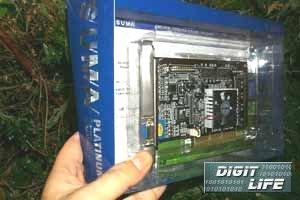 The complete set doesn't differ from the SUMA Platinum GeForce2 GTS 32 MBytes. OverclockingWith this card we managed to overclock the chip up to 230 MHz, the memory was working at 210 MHz what is quite typical the cards of the GeForce2 MX class. Installation and driversSUMA ships together with the card the reference drivers from NVIDIA of 6.18 version. For testing I used 6.47 beta drivers from NVIDIA. 6. SUMA Platinum GeForce2 MX Power Up 32 MBytes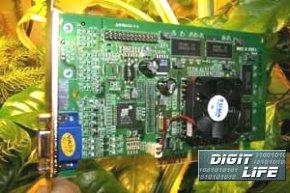 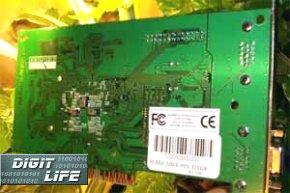 The card has the AGP 2x/4x interface, 32 MBytes SDR SDRAM located in 4 chips on the right side of the PCB. 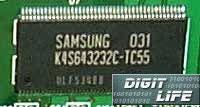 The memory modules have 5.5 ns access time and are produced by Samsung. What differs this card from the previous one is a faster memory. The default memory frequency constitutes 183 MHz. The card is equipped with an active cooler with a heatsink platinic in color similar to that of the SUMA Platinum GeForce2 MX 32 MBytes. But its heatsink is less massive and a fan is a bit larger. You can hope for a good overclocking of the graphics core but not very considerable due to the slow SDR memory. The PCB is golden in color alike the SUMA Platinum GeForce2 GTS 32 MBytes, with again silvery letters of the name. And again neither TV-out nor DVI-output. Once more we will notice that SUMA refused the reference design for the GeForce2 MX. Not so long ago we have received a newrevision of this card with Hyundai chips. 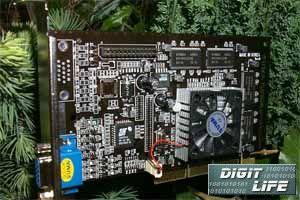 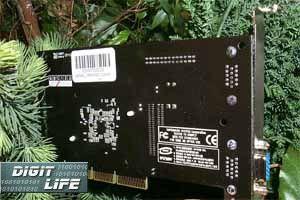 This card differs from its predecessor not only in memory modules but also in color: it is dark brown. The cards are shipping is the box of a legacy design: 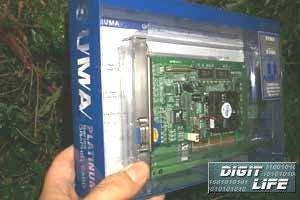 The complete set is the same as for the previous card. OverclockingOn the card with the Samsung chips we managed to overclock the graphics core up to 220 MHz, the memory worked at 210 MHz, and the revision with the Hyundai modules showed the record results for the NVIDIA GeForce2 MX based cards - 230/225 MHz! Installation and driversSUMA ships together with the card the reference drivers from NVIDIA of 6.18 version. For testing I used 6.47 beta drivers from NVIDIA. 7. SUMA Platinum GeForce2 MX SE (Special Edition) TwinView 32 MBytes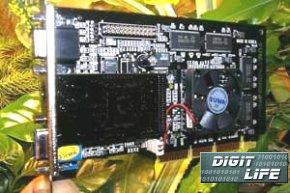  This video card is one of the most interesting models of the GeForce2 MX series from SUMA. The card has the AGP 2x/4x interface, 32 MBytes SDR SDRAM located in 4 chips on the right side of the PCB.  The memory modules have 5.5 ns access time and are produced by Samsung. The default memory frequency constitutes 183 MHz. The card is equipped with the same active cooler as of the previous model. The black PCB has bright silvery letters of the name. The board is supplied with a TV-out and the second VGA interface for the second CRT monitor. Look at the chip of the second RAMDAC located a bit higher than the daughter board with a TV-out. This card has TwinView support. Today there is a new revision of this card with the memory chips from Hyundai. 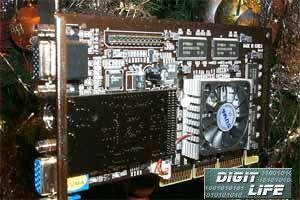 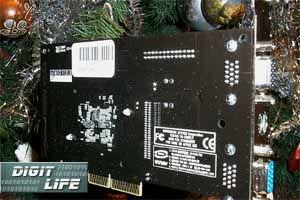 This card differs from its predecessor not only in memory modules but also in color: it is dark brown. The cards are shipping is the box of legacy design: 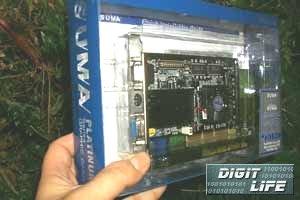 The complete set is the same as for the previous card. OverclockingOn the card with the Samsung chips we managed to overclock the graphics core up to 220 MHz, the memory worked at 210 MHz, and the revision with the Hyundai modules showed 230/225 MHz. Installation and driversSUMA ships together with the card the reference drivers from NVIDIA of 6.18 version. For testing I used 6.47 beta drivers from NVIDIA. TwinViewThis technology from NVIDIA is very similar to DualHead from Matrox, but there is some difference in functionality. Here are the main ways of image output with TwinView enabled:
Two imaging methods: Extended (desktop extension) 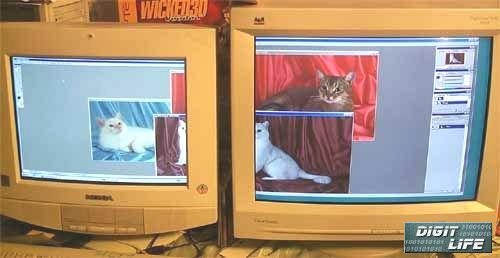 Desktop Clone  The quality of the image on the second display is rather good. Soon in a separate review we'll speak about TwinView technology in depth. 8. SUMA Platinum GeForce2 MX Power Up 32 MBytes with SIF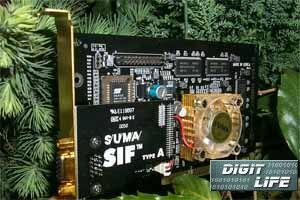  The card has the AGP 2x/4x interface, 32 MBytes SDR SDRAM located in 4 chips on the right side of the PCB.  The memory modules have 5.5 ns access time and are produced by Hyundai. The default memory frequency constitutes 183 MHz. The card has an active cooler with a heatsink golden in color. The fan is made of transparent plastic what accentuates elegance and stylish design of the cooler. 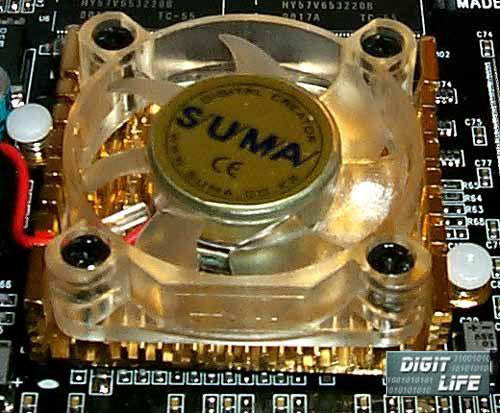 The PCB is dark-brown with bright silvery letters of the name. 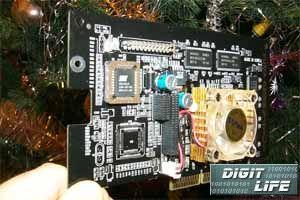 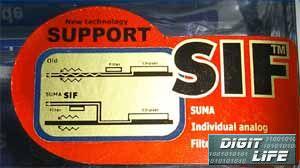 The main distinguishing feature is an output to monitor via the daughter board. I.e. there is no VGA-connectors on the mainboard. What is it for and what does the word SIF mean? SIF stands for SUMA Individual Analog Filter. With a usual design the circuit of output signal gets noise pickups that spoil 2D-quality. On the daughter board they mounted the SIF element that improves image quality; besides, there are no pickups typical for a usual design. That's why one should expect quality gain with such video cards. Note that the company produces two types of SIF daughter boards: with one VGA-connector and with two: 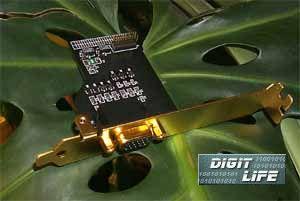 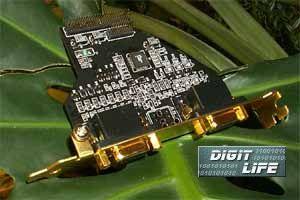 As you can see with the same video card and with different attachments like daughter boards you can assemble both a usual card on the NVIDIA GeForce2 MX with one VGA-output and a TwinView-card. The daughter card of the B type has everything necessary for image output onto two monitors including the second RAMDAC. The cards are shipping is the box of a legacy design:  The complete set is the same as for the previous card. OverclockingOn the card we managed to overclock the graphics core up to 220 MHz, the memory worked at 210 MHz. Installation and driversSUMA ships together with the card the reference drivers from NVIDIA of 6.18 version. For testing I used 6.47 beta drivers from NVIDIA. Test resultsWe'll start with 2D-graphics. In the previous articles we mentioned high quality and excellent speed in 2D which were shown by GeForce2 GTS and GeForce2 MX based cards from NVIDIA. All these cards obtained the results not worse than those of other boards of this class. I'm sure that the video cards from SUMA will provide the majority with qualitative image. The presence of the SIF increases quality in high resolutions and frame rates higher than 85 Hz. But the SUMA video cards (I mean only the GeForce2 MX based cards) couldn't get on with some mainboards and especially with some monitors. The problem is a presence of hardly noticeable vertical stripes or diffuse image. It's not a fault of the cards themselves (when installed into another computer they show excellent quality), but there is something for SUMA to think of in terms of compatibility. Besides, I must notice that the NVIDIA GeForce2 MX video cards get on badly with some not very good displays and can give out a diffuse image. Some users like to lift frame rate higher the defaulted of a definite monitor and then they accuse the video card of it. It's clear that the video card is not responsible for bad image quality. With the following 2 games we will consider speed level in 3D-graphics:
These tools are quite enough to show you the performance of the video cards when working via 2 main API. For you to compare, we give speed results of some other video cards:
Besides, we will show you the performance changes when in overclocking mode. Note that the performance of earlier and later revisions of the GeForce2 MX based video cards at regular frequencies is the same. And speed results of the SUMA Platinum GeForce2 GTS 64 MBytes in the test Expendable don't differ from the 32-mb variant of the same card. The NVIDIA GeForce2 GTS based video cards: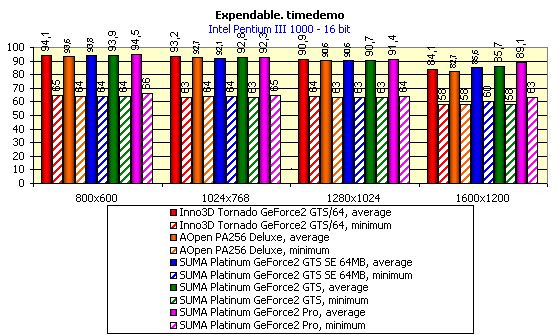 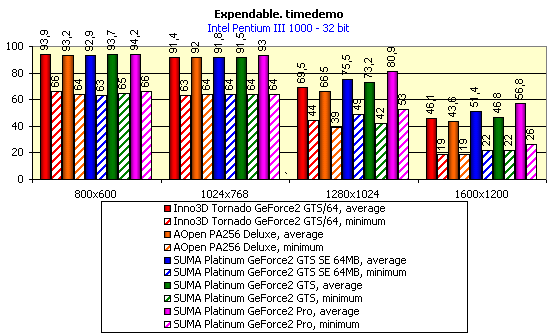 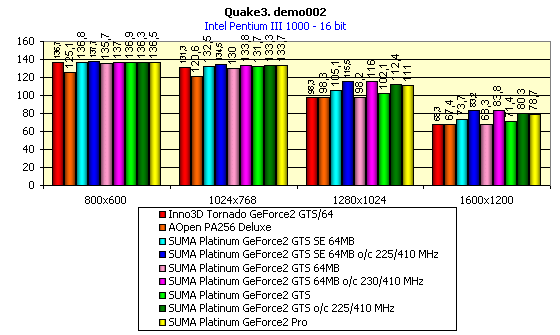 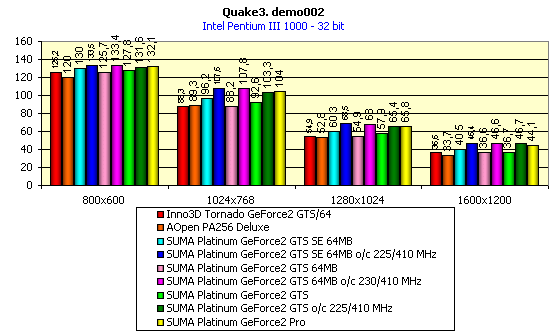 It's easy to see that the performance score of the SUMA Platinum GeForce2 SE 64 MBytes is a bit higher than that of the contestants, what can be explained by a faster memory of this card. The SUMA Platinum GeForce2 32 MBytes and SUMA Platinum GeForce2 Pro cards performed quite well. On the whole, the results of all cards correspond the required level. The greatest performance increase is reached in overclocking mode. The cards worked with minimum external cooling (we installed only one additional fan in the system block). Of course, you shouldn't generalize the results of this certain card to all cards of this series. The NVIDIA GeForce2 MX based video cards: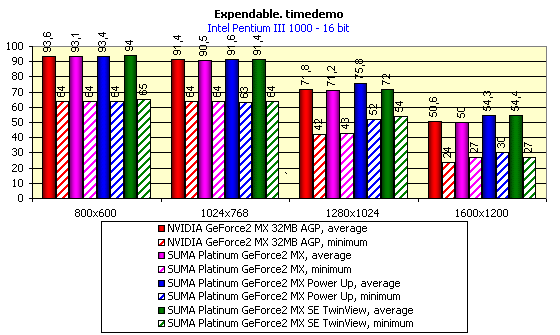 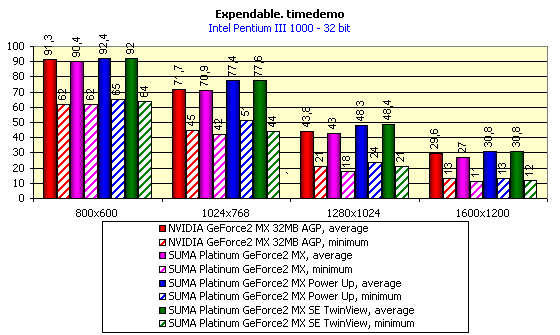 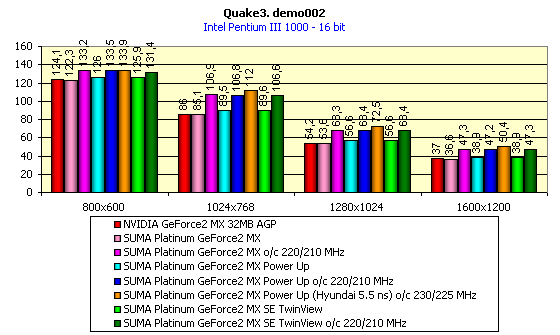  Similar to the previous tests, the performance of SUMA Platinum GeForce2 MX SE and PowerUp video cards is a bit higher than that of the contestants because of higher performance of the local memory. On the whole, the speed results comply with the average results of the boards of this class. ConclusionWe have covered the whole series of the video cards from SUMA (SuperMicro System). The tests reveal that these cards agree with our knowledge of the cards of this class in terms of quality and performance. SUMA products easily compete against the cards of such manufacturers as ASUS or Creative. The SUMA cards have a unique design, a rich complete set and high quality. The price for SUMA production is low, however. For example, 32 MBytes card on the GeForce2 GTS costs approx $200 by retail (the beginning of 2001), and GeForce2 MX based card costs $100 -130 depending on the model and presence of the SIF. By the way, this filter scarcely tells upon the price, that's why I'd recommend all of you to but a video card exactly with SIF. In my opinion, such products deserves fixed attention of resellers who are going to extend the range of their goods. Having bought this card you shouldn't be disappointed. Highs:
Lows:
Write a comment below. No registration needed!
|
Platform · Video · Multimedia · Mobile · Other || About us & Privacy policy · Twitter · Facebook Copyright © Byrds Research & Publishing, Ltd., 1997–2011. All rights reserved. |